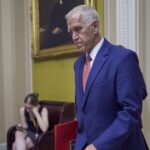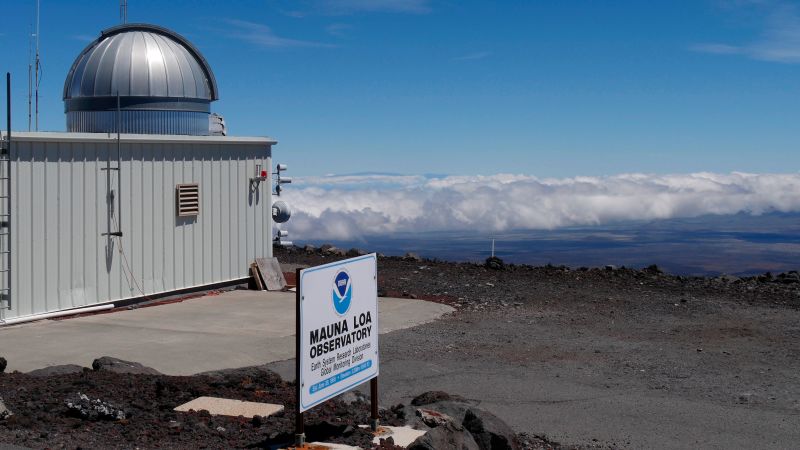The Trump administration’s proposed budget seeks to shutter the Mauna Loa Observatory in Hawaii, a pivotal site for climate change research since the 1950s. This laboratory has provided the most conclusive evidence of human-induced climate change by measuring atmospheric carbon dioxide levels. Alongside other planet-warming pollutants, these measurements have been crucial in understanding the drivers of climate change, including sea level rise and extreme weather events.
The proposed budget would also defund several other climate research facilities, including those forming the U.S. government’s greenhouse gas monitoring network, which extends from Alaska to the South Pole. However, the Mauna Loa Observatory is the most prominent target, as its data has consistently shown the upward trend of CO2 emissions due to human activities. This data is famously represented by the Keeling Curve, named after Charles David Keeling, the scientist who initiated these measurements in 1958.
The Keeling Curve: A Scientific Legacy
The Keeling Curve is one of the most iconic charts in modern science, illustrating the steady increase of atmospheric CO2 over decades. When Keeling began his measurements, the concentration of CO2 was 313 parts per million (ppm). By 2024, this figure had risen to 424.61 ppm, and recently, monthly averages at Mauna Loa exceeded 430 ppm for the first time.
Ralph Keeling, a professor at the Scripps Institution of Oceanography at UC San Diego, now oversees the continuation of his father’s work. The National Oceanic and Atmospheric Administration (NOAA) currently supports these measurements, with additional funding from Schmidt Sciences and Earth Networks.
“The Keeling Curve is not just a graph; it is a vital record of our impact on the planet,” said Ralph Keeling.
Potential Impacts of Shutting Down Mauna Loa
The closure of Mauna Loa would represent a significant disruption to climate science. In the event of a shutdown, Scripps may seek alternative funding to maintain the instruments at their current location or face the challenge of relocating them, potentially introducing a discontinuity in the data record.
The proposal to close Mauna Loa was detailed in a budget document submitted to Congress, aligning with Project 2025, a conservative plan to overhaul government operations. This initiative aims to eliminate all climate-related research at NOAA, redirecting its focus towards operational weather forecasting and warnings.
Broader Implications for Climate Research
NOAA has long been a leader in climate science, contributing to global understanding and policy. The proposed budget cuts could undermine these efforts, affecting not only climate research but also advancements in weather forecasting.
Experts warn that losing such a critical data source could hinder efforts to combat climate change. The Mauna Loa Observatory’s data is essential for international climate agreements and policy-making, providing a long-term perspective on atmospheric changes.
“Eliminating this research would be a setback for global climate science,” stated a climate policy expert.
Looking Forward
As the budget proposal moves through Congress, stakeholders in the scientific community are advocating for the preservation of these critical research efforts. The decision will have lasting implications for both national and international climate initiatives.
While the future of the Mauna Loa Observatory hangs in the balance, the scientific community emphasizes the importance of maintaining a continuous and comprehensive record of atmospheric CO2 levels.
CNN has reached out to NOAA and Scripps for comment on the proposed budget cuts and their potential impact on ongoing research.
About The Author
 Wall Street Faces Losses Amid Dollar’s Continued Decline in 2025
Wall Street Faces Losses Amid Dollar’s Continued Decline in 2025 UK Records Hottest Day of 2023 as Heatwave Intensifies
UK Records Hottest Day of 2023 as Heatwave Intensifies Sen. Thom Tillis Joins List of Republicans Exiting Amid Trump Tensions
Sen. Thom Tillis Joins List of Republicans Exiting Amid Trump Tensions Trump Lifts U.S. Sanctions on Syria, Aiming for Regional Stability
Trump Lifts U.S. Sanctions on Syria, Aiming for Regional Stability Lululemon Files Lawsuit Against Costco Over Alleged ‘Dupe’ Sales
Lululemon Files Lawsuit Against Costco Over Alleged ‘Dupe’ Sales